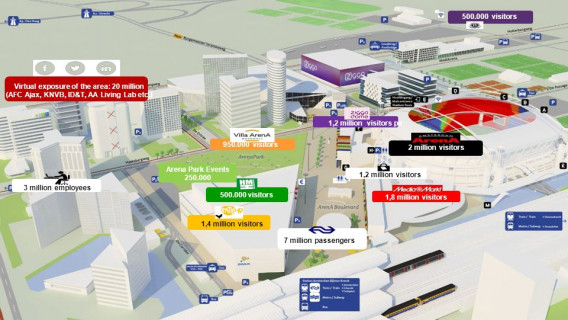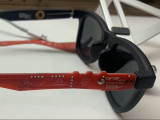The Mobility Portal offers visitors of venues the best travel advice at that moment (real time), which they can immediately book online.
Smart Stories
Check the article about the Mobility Portal featured in our online magazine 'Smart Stories':

The Mobility Portal offers visitors of venues the best travel advice at that moment (real time), which they can immediately book online.
Check the article about the Mobility Portal featured in our online magazine 'Smart Stories':
Most of the visitors (and employees) of venues want advice in advance about their trip to this venue. The Mobility Portal offers visitors the best travel advice at that moment (real time), which they can immediately book online. For example available parking space, a train or bus ticket, a hotel room or a taxi. Visitors are also better informed and prepared for their journey, which can help to prevent traffic jams.
A better experience for travelers to venues, without traffic jams or problems how to get there. Mobility Portal give advice about the best route to travel, along traffic jams and to the best reachable parking locations. Cities will benefit from Mobility Portal, because they have a tool to advice and guide travelers online and in advance of their journey. The Mobility Portal is for events at the ArenA area already up and running. We would also like other areas and venues to benefit from it.
The project is initiated by BeSite and the Amsterdam ArenA, in cooperation with the city of Amsterdam. Also several service providers and other venues at the ArenA area are also connected.
We want to connect more venues, more service providers and more (open) data connectors with relevant mobility data for travelers.
Most guidance programs give travelers advice during their trip, or when travelers arrive at the venue. We discovered that travelers are willing to follow advice in advance, but only if the advice is real time and extended. This is a big opportunity for the future. Now we can manage visitors in advance and online, instead of only at the place of arrival.
Get notified about new updates, opportunities or events that match your interests.

During this evening Paul Stefaan Mooij will introduce the DIY Smart Glasses he developed, he is bringing several 'arms'. The PMSG kit lets you swap out those boring old arms from your (sun)glasses for a custom-made PCBA that looks and functions like something a hacker MacGyver would dream up. It fits just like the original—using the same hinges, screws, and probably duct tape somewhere—but now you’ve got space for sensors, connectors, and all the IoT magic you can pack onto your temples.
Join us to experiment, learn and envision new sensors and possibilities.
https://www.hackster.io/psmooij/pmsg-prototype-modular-smart-glasses-8bd4e6
https://github.com/Control-C/PMSG
You don't have to rsvp via meetup, the workshop is from 19-21h in the Makerspace of the OBA and you can just walk in!
OBA: Oosterdokskade 143, 1011DL Amsterdam

Learn with the case study Amsterdam to anticipate future food disruptions. Understand the city's food supply chain vulnerabilities is critical for enhancing food resilience. Enhance food resilience in empowerment of people in urban food growing.

Join us for an exclusive webinar featuring three leading European cities sharing their proven strategies for EV charging infrastructure placement. Learn from real-world experiences and discover data-driven approaches that are transforming urban mobility across Europe.
𝗪𝗵𝗮𝘁 𝗬𝗼𝘂'𝗹𝗹 𝗟𝗲𝗮𝗿𝗻
🏙️ 𝗦𝘁𝗿𝗮𝘁𝗲𝗴𝗶𝗰 𝗣𝗹𝗮𝗰𝗲𝗺𝗲𝗻𝘁 𝗔𝗽𝗽𝗿𝗼𝗮𝗰𝗵𝗲𝘀 - Discover how Brighton & Hove, Oslo, and Metropolitan Region of Amsterdam Electric have developed their EV charging strategies
📊 𝗗𝗮𝘁𝗮-𝗗𝗿𝗶𝘃𝗲𝗻 𝗗𝗲𝗰𝗶𝘀𝗶𝗼𝗻 𝗠𝗮𝗸𝗶𝗻𝗴 - Learn about the tools and methodologies these cities use to optimize charging point locations
🚗 𝗦𝗲𝗿𝘃𝗶𝗻𝗴 𝗔𝗹𝗹 𝗥𝗲𝘀𝗶𝗱𝗲𝗻𝘁𝘀 - Understand how to address the needs of residents without private parking spaces
🌍 𝗜𝗻𝘁𝗲𝗿𝗻𝗮𝘁𝗶𝗼𝗻𝗮𝗹 𝗕𝗲𝘀𝘁 𝗣𝗿𝗮𝗰𝘁𝗶𝗰𝗲𝘀 - Gain insights from three different countries and municipal perspectives
💡 𝗟𝗲𝘀𝘀𝗼𝗻𝘀 𝗟𝗲𝗮𝗿𝗻𝗲𝗱 - Avoid common pitfalls and learn from real implementation experiences
𝗙𝗲𝗮𝘁𝘂𝗿𝗲𝗱 𝗦𝗽𝗲𝗮𝗸𝗲𝗿𝘀
Kieran Fitsall - Brighton & Hove Council
Sture Portvik & Sara Teige Kalsaas - City of Oslo
Annekee de Jager - MRA-e (Amsterdam Metropolitan Region)
Hosted by Sanne van Breukelen - Cenex Nederland
𝗪𝗵𝘆 𝗔𝘁𝘁𝗲𝗻𝗱?
With Europe requiring 6.8 million public charging points by 2030, municipalities face unprecedented challenges in planning and implementing EV infrastructure. This webinar brings together three cities that have successfully navigated these challenges, offering practical insights for:
- Municipal planning departments
- Urban mobility professionals
- EV infrastructure developers
- Policy makers and city officials
- Transport consultants
𝗞𝗲𝘆 𝗧𝗼𝗽𝗶𝗰𝘀 𝗖𝗼𝘃𝗲𝗿𝗲𝗱
- Historical approaches vs. modern data-driven strategies
- Stakeholder engagement
- Grid capacity considerations and smart charging integration
- On-street charging solutions for urban residents
𝗪𝗵𝗼 𝗦𝗵𝗼𝘂𝗹𝗱 𝗔𝘁𝘁𝗲𝗻𝗱
This webinar is essential for anyone involved in:
- Urban planning and development
- Sustainable transport initiatives
- EV infrastructure deployment
- Municipal policy development
- European mobility strategy
𝗥𝗲𝗴𝗶𝘀𝘁𝗿𝗮𝘁𝗶𝗼𝗻
Don't miss this opportunity to learn from Europe's leading cities in EV infrastructure planning. Register now to secure your spot and gain access to exclusive insights that could transform your city's approach to EV charging.
---
This webinar is part of Cenex's ongoing commitment to accelerating the transition to sustainable transport through knowledge sharing and best practice dissemination across European cities.


Hi there!
We are a group of students from Lund University (Sweden), studying our Master in Information Systems. In one of our courses, we are doing a research about sustainable/smart cities in Europe and after reading about Amsterdam, the choice of city became easy!
By looking at this project, we see that you would fit very well in an interview about the smart city initiatives in Amsterdam from an entreprenoural point of view. We would be very grateful if you took your time to help us out answering our questions, which will take around 45 min - 1 hour.
If you would like a copy of our report when it is finished, we’ll gladly share it with you!
Please contact me as soon as possible and I will explain more: fredriksson.otto@gmail.com
Best Regards,
Cheng Ruijing
Fredrik Waldau
Otto Fredriksson
Rexhep Haliti